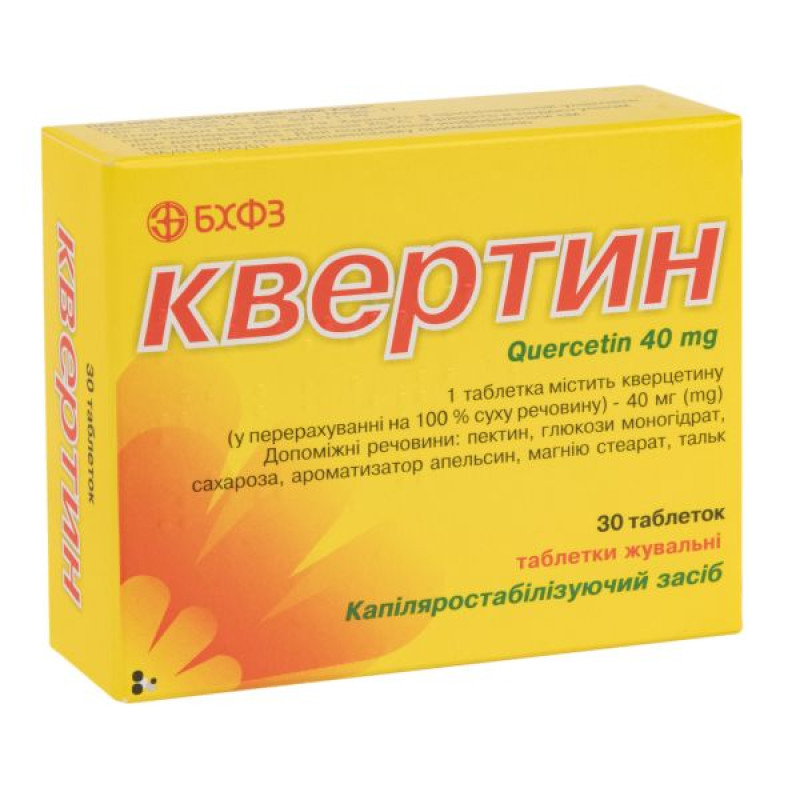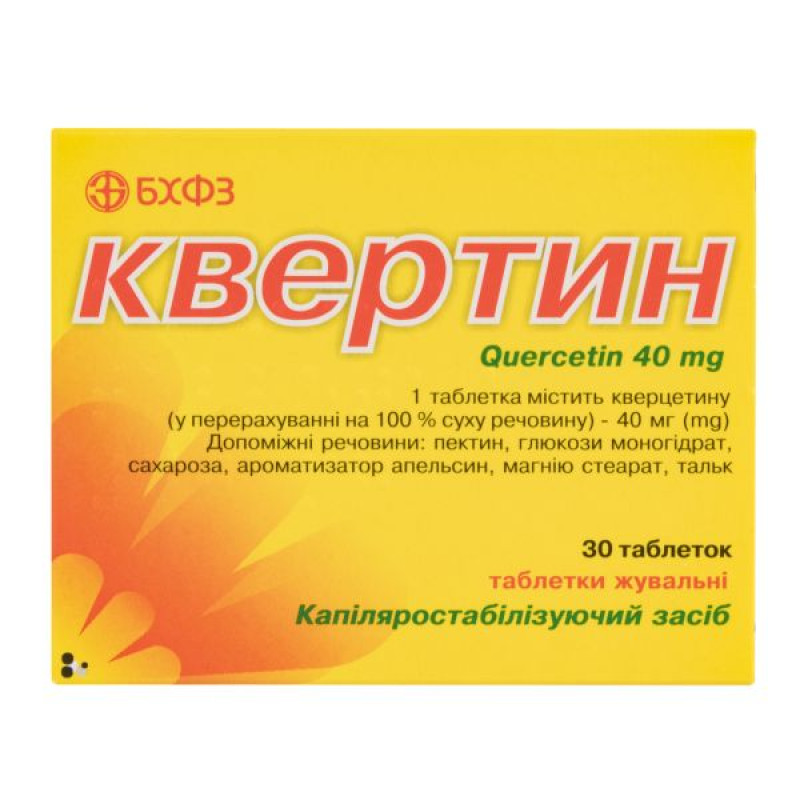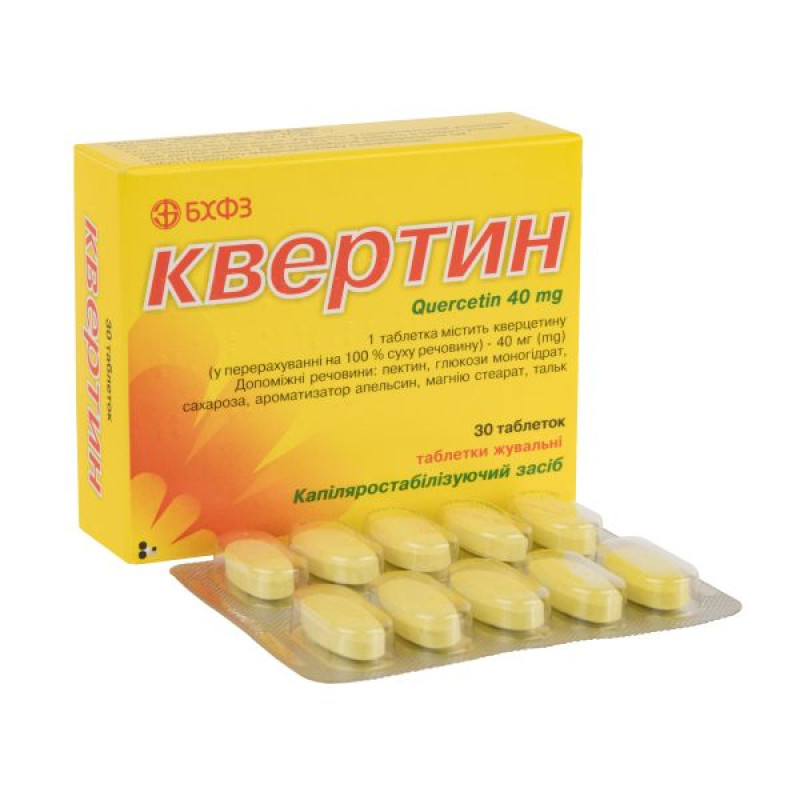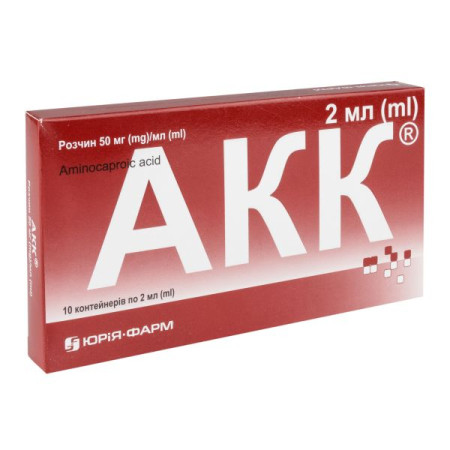Quertin chewable tablets 40 mg blister No. 30

Instructions for use Quertin chewable tablets 40 mg blister No. 30
Composition
active ingredient: quercetin;
1 tablet contains quercetin (calculated as 100% dry matter) – 40 mg;
excipients: pectin, glucose monohydrate, sucrose, orange flavoring, magnesium stearate, talc.
Dosage form
Chewable tablets.
Main physicochemical properties: oval-shaped tablets of yellow with a greenish tint with inclusions, with a biconvex surface. The tablets have a specific taste and smell.
Pharmacotherapeutic group
Angioprotectors. Other capillary stabilizing agents.
ATX code C05C X.
Pharmacological properties
Pharmacodynamics.
The flavonoid quercetin is an aglycone of many plant flavonoid glycosides, including rutin. The pharmacological properties of quercetin are due to the pronounced antioxidant activity of the drug. Due to its capillary-stabilizing properties associated with antioxidant and membrane-stabilizing effects, the drug reduces capillary permeability. Quercetin has an anti-inflammatory effect, which is due to the blockade of the lipoxygenase pathway of arachidonic acid metabolism, a decrease in the synthesis of leukotrienes, serotonin and other inflammatory mediators. Quercetin has a gastroprotective effect.
The cardioprotective properties of quercetin are associated with increasing the energy supply of cardiomyocytes due to its antioxidant effect and improving blood circulation.
The positive effect of quercetin on the processes of rehabilitation of brain functions in adults in the early recovery period after ischemic stroke is manifested in a decrease in the degree of post-stroke disability, restoration of impaired neurological functions, as well as in the regression of cognitive deficits, reduction of anxiety, improvement of mood, and in the positive attitude of patients towards the restoration of quality of life.
The reparative properties of quercetin accelerate wound healing. The drug can affect the processes of bone tissue remodeling, it has a stable immunomodulatory activity.
Diuretic, antispasmodic, and antisclerotic properties have also been experimentally determined. Quercetin is able to normalize blood pressure and stimulate insulin release, inhibit thromboxane synthesis, and slow platelet aggregation.
Quercetin also binds to estrogen receptors. Due to its estrogen-like properties (effect on proline hydroxylase, inhibition of tumor necrosis factor and interleukin synthesis), the drug has proosteoclast effects.
Clinical trials
The study of the effectiveness of the sequential use of the drugs Corvitin and Quertin as pathogenetic treatment of pneumonia associated with COVID-19 coronavirus infection, against the background of basic therapy, was conducted as part of a clinical study: "An open, multicenter, randomized study to study the effectiveness of the drug Corvitin, lyophilized powder for preparation of injection solution 0.5 g, manufactured by PJSC NVC "Borshchagivskyi KhFZ" with the subsequent use of the drug Quertin, chewable tablets 40 mg, manufactured by PJSC NVC "Borshchagivskyi KhFZ" in patients with pneumonia associated with 2019-nCoV acute respiratory disease, against the background of basic therapy." The study involved 200 adult patients of both sexes.
The results of the study proved the predominant effectiveness in the main variable, which was defined as the time to normalization of most of the symptoms of the disease. Thus, the addition of the drugs Corvitin® and Quertin to the basic therapy leads to an increase in the saturation level and an acceleration of recovery (by 2 days) compared to the control group.
Due to its membrane-stabilizing, antioxidant, and endothelium-protective effects, the use of the drug Corvitin with the subsequent use of the drug Quertin against the background of basic therapy helps stabilize the level of D-dimer in the blood of patients with pneumonia associated with coronavirus disease.
The study of the effectiveness of the drug Quertin against the background of basic therapy for chronic ischemic heart disease (stable angina of exertion of II–III functional class) against the background of stage I–II hypertension with 1–2 degrees of arterial hypertension in patients aged 60–75 years inclusive was conducted as part of the clinical study “Multicenter, randomized, single-blind, placebo-controlled study to study the efficacy and safety of the drug Quertin, chewable tablets, manufactured by PJSC SVC “Borshchagovskyi HFZ” in elderly patients with chronic ischemic heart disease against the background of hypertension”. 200 adult patients of both sexes participated in the study.
The results of the clinical trial proved the superior effectiveness of the drug Quertin compared to placebo in the treatment of elderly patients with chronic ischemic heart disease on the background of hypertension.
When comparing the indicators of the Seattle Questionnaire scales in two groups of patients during the treatment process, a statistically significantly better positive dynamics of scores on all scales was revealed in the main group compared to the control group.
Analysis of the effect of treatment in patients of the main and control groups on Doppler flowmetry indicators made it possible to establish a statistically significant increase in the maximum volumetric velocity of skin blood flow (OSVSKmax) and trel in patients of the main group (basic therapy + Quertin) and the absence of changes in these indicators in patients of the control group (basic therapy + placebo). The results obtained indicate an improvement in the vasomotor function of the microvascular endothelium under the influence of the drug Quertin.
Based on the analysis of the dynamics of systolic and diastolic blood pressure levels, a decrease in both indicators after treatment was found in both the main and control groups. At the same time, there was a statistically significant decrease in systolic blood pressure after treatment in patients in the main group (basic therapy + Quertin) compared to the control group (basic therapy + placebo).
No statistically significant differences were found between the groups in terms of atherogenicity coefficient.
Thus, the results of the assessment of primary and secondary criteria of treatment effectiveness allow us to draw a general conclusion regarding the predominant effectiveness of the course use of the drug Quertin at a dose of 240 mg per day in elderly patients with chronic coronary artery disease on the background of hypertension.
Pharmacokinetics.
Didn't study.
Indication
As part of the complex treatment:
ischemic heart disease, angina pectoris of functional class II–III;
chronic ischemic heart disease (stable angina of exertion of II–III functional class) against the background of hypertension of I–II stage in patients aged 60–75 years;
in the early recovery period after ischemic stroke in adults;
pneumonia caused by COVID-19 coronavirus infection in adults;
neurocirculatory dystonia;
to prevent erosive-ulcerative lesions of the upper digestive tract caused by taking nonsteroidal anti-inflammatory drugs;
purulent-inflammatory diseases of soft tissues;
climacteric, vertebral pain syndrome;
neuroreflex manifestations of spinal osteochondrosis;
chronic glomerulonephritis.
Contraindication
Hypersensitivity to quercetin and other components of the drug, as well as to drugs with P-vitamin activity.
Interaction with other medicinal products and other types of interactions
When using quercetin:
with ascorbic acid preparations, summation of effects is observed;
with nonsteroidal anti-inflammatory drugs, the anti-inflammatory effect of the latter is enhanced while the ulcerogenic effect is reduced;
with digoxin, the maximum serum concentration and the total area under the digoxin concentration-time curve increase;
with cyclosporine, the bioavailability and blood concentration of cyclosporine increases;
with paclitaxel – effect on the metabolism of the latter;
with verapamil, the bioavailability of the latter increases;
with tamoxifen, bioavailability increases, metabolism and excretion of the latter decrease.
Application features
Since the drug contains sucrose and glucose, patients with hereditary intolerance to fructose, glucose-galactose, sucrose-isomaltose should not use the drug.
Quertin chewable tablets should be used with caution in patients wearing removable dentures.
The drug should be used with caution in patients with diabetes.
When treating patients with pneumonia caused by COVID-19 coronavirus infection, Quertin is used sequentially with the drug Corvitin® and in combination with basic therapy drugs.
Use during pregnancy or breastfeeding
It is not recommended to use the drug during pregnancy or breastfeeding.
If it is necessary to prescribe the drug, breastfeeding should be discontinued for the period of treatment.
Ability to influence reaction speed when driving vehicles or other mechanisms
Does not affect.
Method of administration and doses
The drug should be taken orally 30 minutes before meals. Chew the tablets with a small amount of water.
In the early recovery period after ischemic stroke, as part of complex treatment, the drug is prescribed to adults according to the following scheme: 1 tablet 3 times a day for 60 days. Further appointment of repeated courses is determined by the doctor.
In the complex treatment of ischemic heart disease, neuroreflex manifestations of spinal osteochondrosis, chronic glomerulonephritis, as well as to prevent the ulcerogenic effect of nonsteroidal anti-inflammatory drugs, the drug is prescribed to adult patients at a dose of 1 tablet 3 times a day. In the complex treatment of purulent-inflammatory diseases of soft tissues, 1 tablet 2 times a day. When used simultaneously with nonsteroidal anti-inflammatory drugs, adults should use Quertin orally at a dose of 2 tablets 3 times a day.
For neurocirculatory dystonia, the drug is administered orally, 2 tablets 2 times a day for a month.
In the complex treatment of climacteric and vertebral pain syndrome, it is recommended to take 1 tablet 3 times a day. The treatment period is 6 months.
As part of the complex treatment of pneumonia caused by COVID-19 coronavirus infection, the drug is prescribed to adults 2 tablets 3 times a day for 10 days after the previous use of the drug Corvitin, lyophilisate for solution for injection according to the following scheme: 1-4 days, 0.5 g 2 times a day with an interval of 12 hours, 5-10 days, 0.5 g 1 time a day.
Children
There is no experience with the use of Quertin in children under 12 years of age, therefore the drug is not recommended for use in this age group.
Overdose
There is no information on overdose with quercetin. It is possible that side effects may be exacerbated.
Treatment is symptomatic.
Side effects
The following may occur: headache, tingling sensation in the extremities, nausea, hypersensitivity reactions including rash, itching.
Expiration date
4 years.
Storage conditions
Store in the original packaging at a temperature not exceeding 25 °C.
Keep out of reach of children.
Packaging
10 tablets in a blister, 3 blisters in a pack; 90 tablets in a container.
90 tablets per container, 1 container per pack.
Vacation category
Without a prescription.
Producer
Public Joint Stock Company "Research and Production Center "Borshchagov Chemical and Pharmaceutical Plant".
Address
Ukraine, 03134, Kyiv, Myru St., 17.
There are no reviews for this product.
There are no reviews for this product, be the first to leave your review.
No questions about this product, be the first and ask your question.









